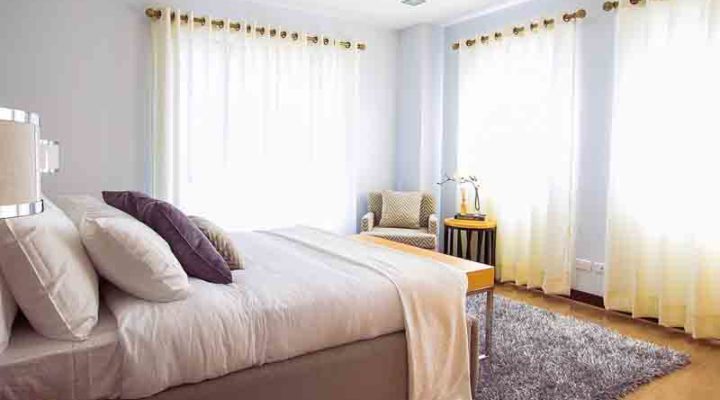
A day has 24 hours. On average, you spend eight hours of it sleeping. That’s one-third of the day in the bedroom. To make sure you actually get your needed hours of quality sleep, you need to create a sleep-inducing environment. This depends on many factors, including the color scheme, the choice of mattress, the temperature, and other things you will read about in this post. If you feel your bedroom doesn’t provide you what you need, there are some things you can do to get some decent shut-eye every night.
Repaint in soothing hues
While red might be your favorite color when it comes to choosing t-shirts and dresses, it is far from being the best choice for your bedroom, because it is too intense and it produces stress and anxiety. It is best to outfit your bedroom with calming hues from a cool-color family, such as green, blue, or purple. Neutral tones, like beige and sand, are also excellent solutions. When choosing a paint color, opt for low or zero-VOC products, to avoid the release of toxins into the air.
Invest in a quality mattress
The choice of mattress is one of the most important ones you will have to make when decorating your bedroom. The wrong choice could be uncomfortable (too soft or too hard), or it could keep you up at night while your partner is tossing and turning. It is wise to go with a memory foam product which adapts to your sleeping position and doesn’t make noise.
Consider your pillows and bedding
A bed pillow is just as significant as the mattress. It should support your head and neck while being adequate for your sleeping position. A prevalently back sleeper won’t use the same pillow as a stomach sleeper. There is a wide range of different pillow stuffing, sizes, and shapes, and each of these factors should be considered when deciding. The sheets and pillow covers should be hypoallergenic and made of natural materials which don’t release fumes into the air.
A soft place to land on
If there is anything awful about the bedroom, that is waking up in the morning and realizing you have to go to work. This feeling gets even worse if you have to stand on a cold floor when getting up from the bed. Companies doing carpet installation in Sydney solve this problem on a daily basis. Besides providing you with a warm landing, carpets can also contribute to sound insulation, so you and your partner wouldn’t have to wake each other up when getting up earlier or in the middle of the night.
Ban daylight from the room
There is nothing wrong with the sunlight entering your bedroom during the day, but let’s say it’s Saturday morning, and you want to sleep in for an extra few hours. The light creeping into your room way too early would be a disturbance. Some of the simple and cost-effective ideas to prevent this from happening are drapery panels and Roman shades.
Clear the clutter
Too much clutter can cause stress, anxiety, and consequently sleep deprivation. Try to keep clutter at bay by having a dedicated storage space for all your things. Try not to keep your clothes or anything piled up on the furniture. Busy patterns can also cause visual clutter, so you should refrain from using them.
Keep the temperature just right
Air temperature that is too hot or too cold inside the bedroom can affect how you sleep at night. According to Sleep.org, the ideal bedroom temperature for sleeping is between 60 and 67 degrees Fahrenheit. This can be achieved by altering the thermostat or by introducing a ceiling fan into your bedroom.
Keep the air fresh
Pet dander, pollen, and dust all inhabit the indoor air. In more severe cases, they can trigger an allergy, but don’t think they are harmless if you are not prone to allergies. They can still pile up in the air, and you can breathe them in on a daily basis. You can get rid of these allergens by getting an air purifier and including several air-purifying plants.
A good night’s sleep is just a few decor projects away. Don’t let it wait any longer.
Leave a Reply